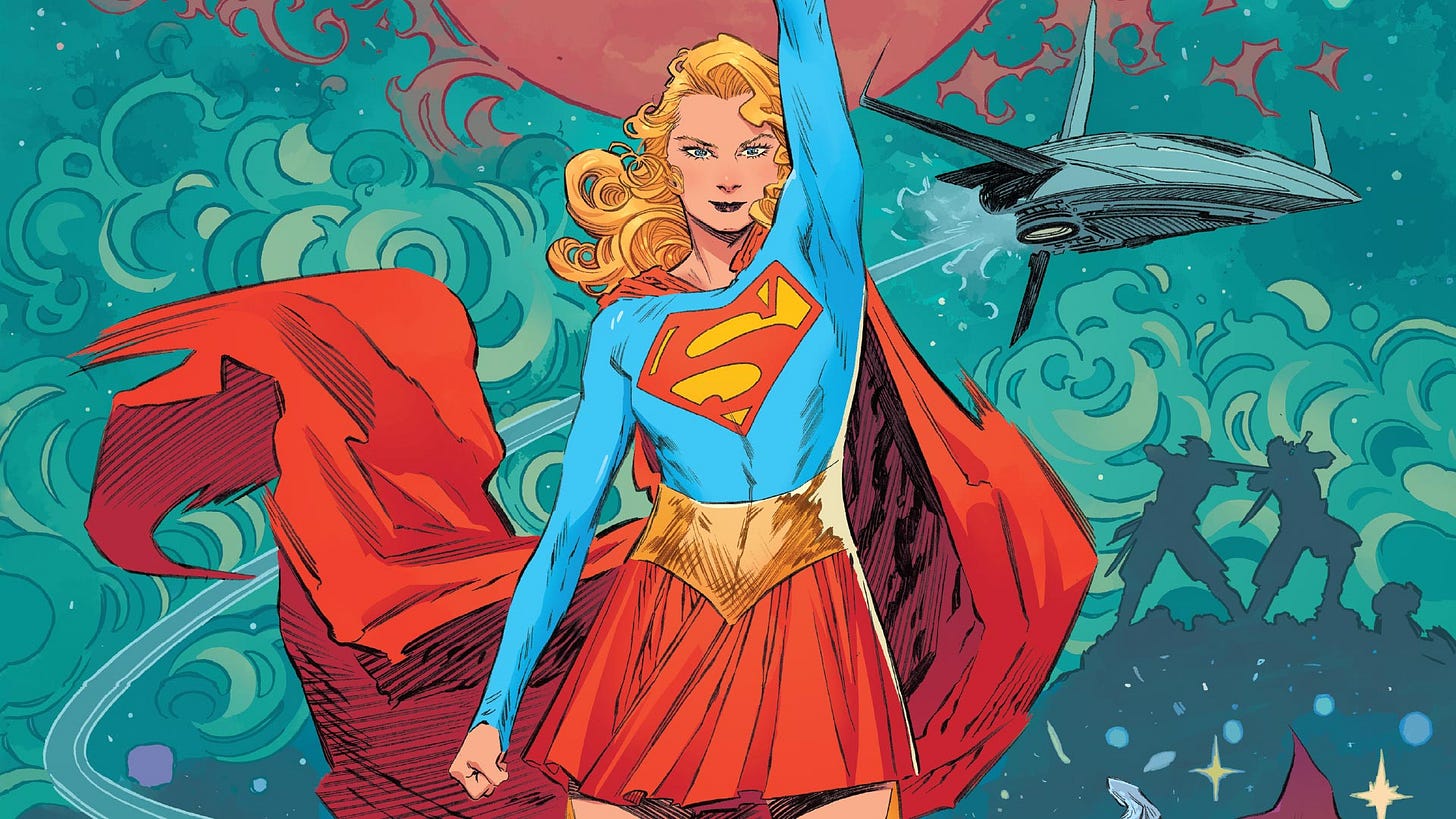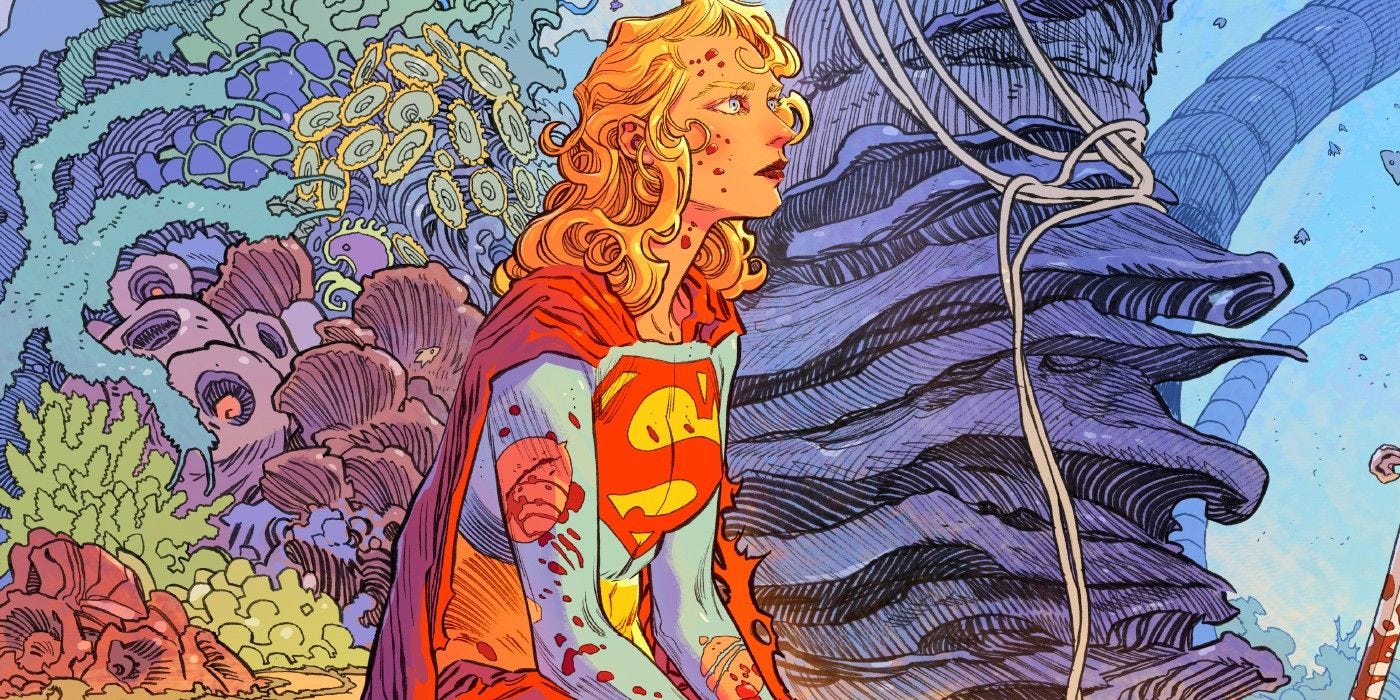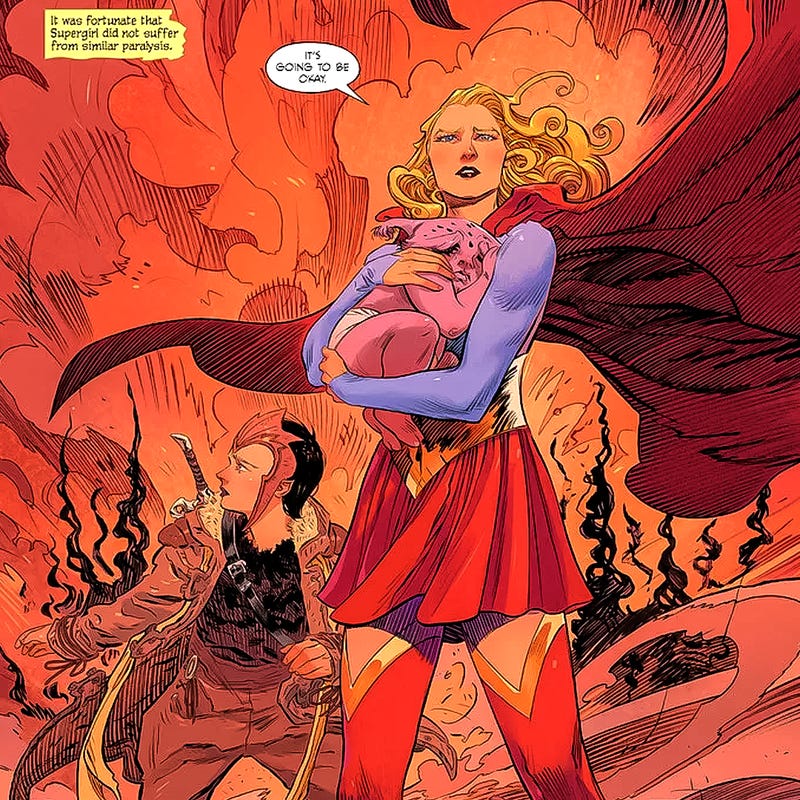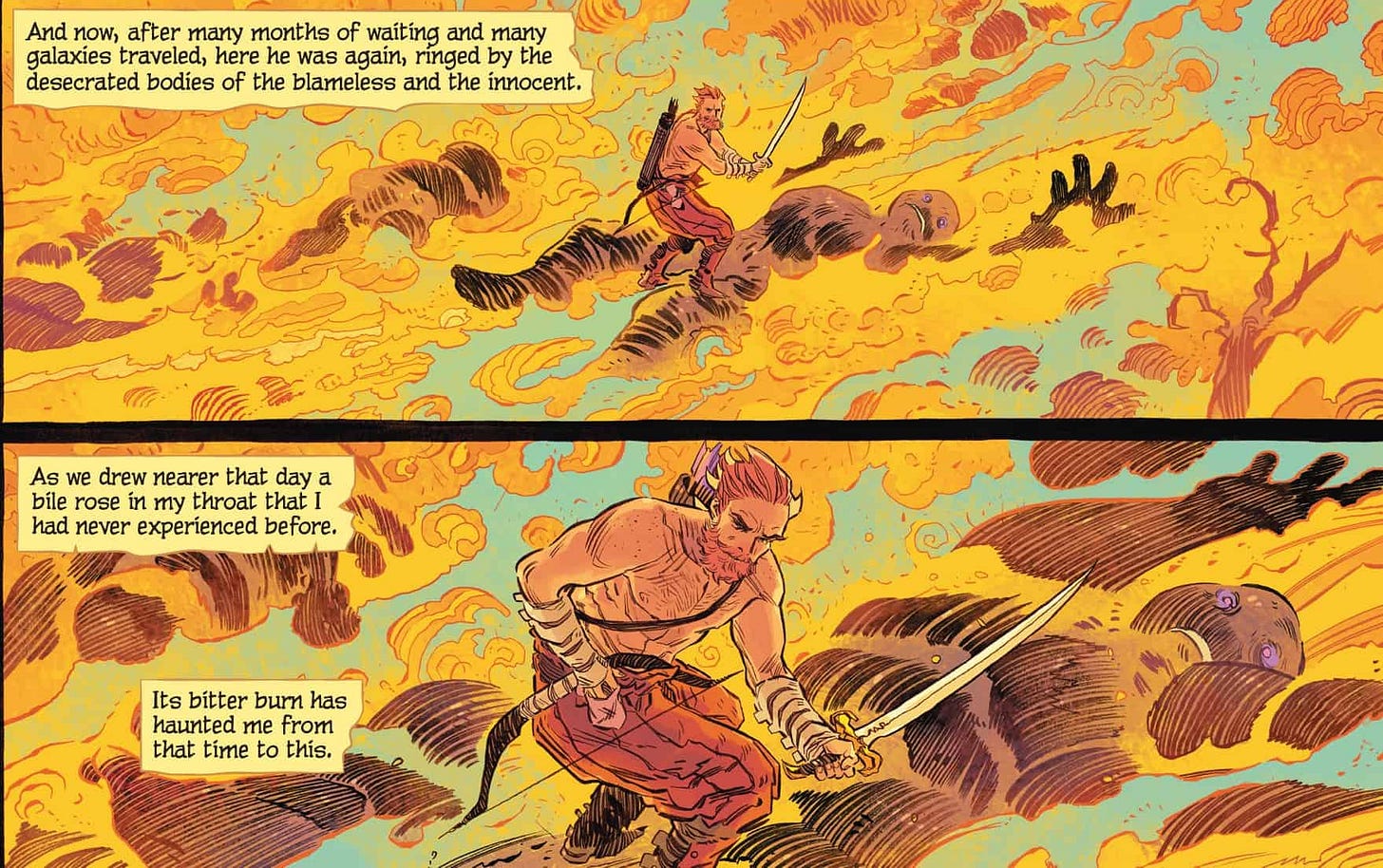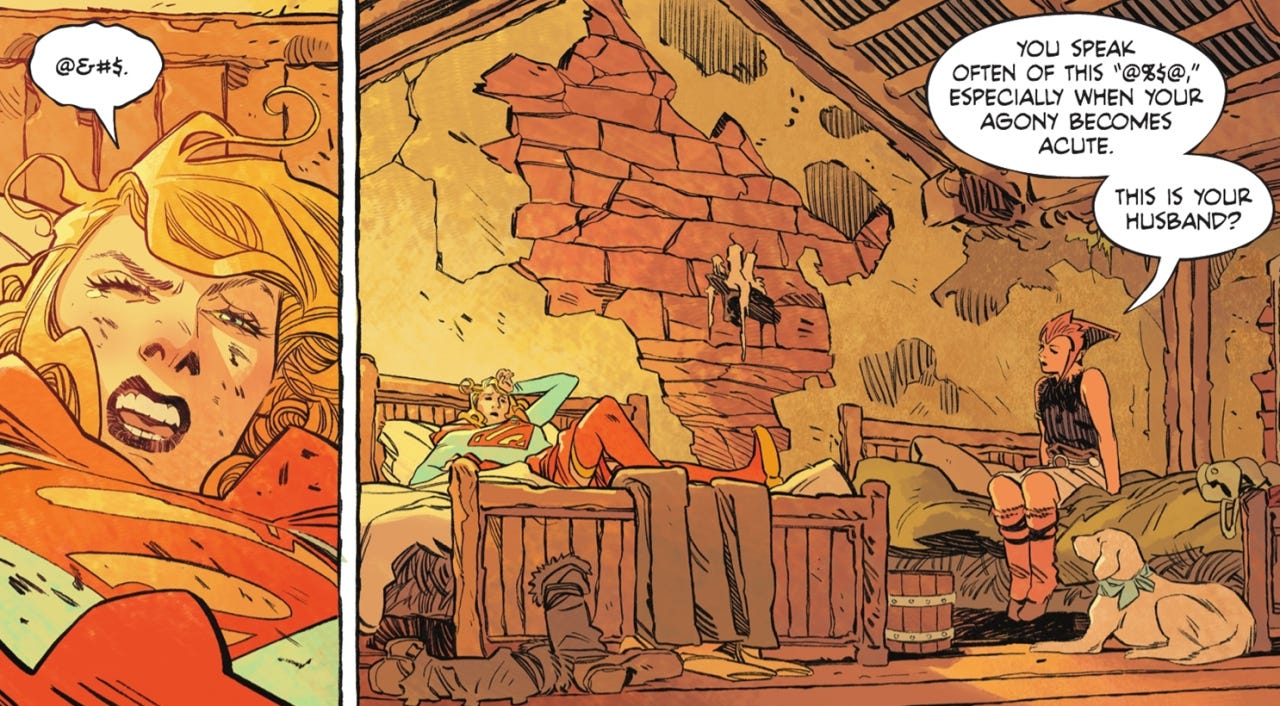Hello, one and all!
Time for another change of pace! I recently subscribed to DC Universe Infinite, the DC Comics subscription service. Over the past few months, I’ve been catching up with all things DC, from old favorites to modern classics. This includes the critically acclaimed 2021 mini-series Supergirl: Woman of Tomorrow, by Tom King and Bilquis Evely.
To preface things, I’ve never been a big reader of Supergirl comics. I was a senior in high school by the time I even started reading Superman, so before Supergirl: Woman of Tomorrow, the character was always in my periphery. The most familiarity I got with Supergirl was in the TV show, starring the wonderful Melissa Benoist.
From there, I got the basics of the character. Kara Zor-El is Superman’s older cousin who was sent to Earth to protect her baby cousin after the destruction of Krypton. There was only one twist: due to a wild ride through space (the TV show says Kara got stuck in the Phantom Zone, don’t worry about it), by the time Kara reached Earth, Kal-El had already grown up and become Superman.
I always found this premise very interesting. If Kal-El had already grown into the ultimate superhero, what was Kara’s purpose now? More importantly, what was it like for Kara to experience the loss of everyone she knew and loved? While Superman was only a baby when Krypton was destroyed, Kara was significantly older, retaining memories of a life that is now gone. There’s a lot of material to explore in these differences between Superman and Supergirl.
Fortunately, Supergirl: Woman of Tomorrow explores these differences in spades. The 8-issue mini-series sends Supergirl on a new adventure while simultaneously reexamining Kara’s origin and the impact it has on the character. This mini-series was a massive hit, being praised as not only one of the best DC Comics of the year, but one of the best comics around, period.
Supergirl: Woman of Tomorrow is told from the perspective of an alien named Ruthye Marye Knoll. The story begins when Ruthye’s father is murdered by a man named Krem. Ruthye seeks revenge, looking for anyone who she can hire to hunt Krem down. During her search, Ruthye happens upon, you guessed it, Kara Zor-El. And she is drunk as a skunk.
Celebrating her 21st birthday, Supergirl is getting appropriately wasted until she protects Ruthye from a bounty hunter that Ruthye was trying to hire. Classic meet cute. In awe of Kara’s strength and heroism, Ruthye tries to hire her instead. Kara initially refuses and tells Ruthye that killing is bad. As I’m often told (kidding, honest).
Things change when Krem ambushes Kara, nearly killing her and her dog, Krypto (not Krypto!) and making off with her spaceship. Surviving this encounter, Supergirl ultimately agrees to help Ruthye find Krem and bring him to justice (or vengeance, it’s kind of a moral debate at this point in the story).
From here, our girls head off on a cosmic road trip, where they encounter all sorts of troublemakers. Think True Grit, but in space. Replace the guns and cigarettes with superpowers and swords and you’re basically there.
Kara and Ruthye run into trouble on the bus, in bars, and saving the bus from a giant space dragon. And that’s just in the second issue! A host of trials await our heroes, including a planet of racists, genocidal pirates called the Barbond’s Brigands, and a planet designed to kill Kryptonians.
And it’s all written so beautifully. Each issue of the series is incredibly dense, telling its own unique tale within one larger narrative. There is a lot of narration, and that might be taxing for some. In an age of decompression in comics, the visuals usually tend to do the talking.
But I find the narration in this story to be more additive than anything. Tom King’s narration serves several different functions, such as describing Ruthye’s point of view, teaching us more about Ruthye and her life, Ruthye’s thoughts on Kara, and sometimes simply to give us some prose to accompany the illustrations. I don’t love everything that Tom King writes, but I cannot deny that he’s a fantastic writer.
One reason that I tend to like King’s mini-series over his ongoing series is that he can write a succinct character study like few others. If you give the guy dozens of issues on Batman, you’ll fall asleep (just my opinion, don’t hate). But give the guy anywhere from 4-12 issues with a character and you’ll fall in love.
And hey, I think 2019’s Batman Annual #4, by Tom King, Jorge Fornes, and Mike Norton, is one of the best single issues of Batman ever. But I digress. Supergirl: Woman of Tomorrow is, first and foremost, a character study. And not just for Supergirl.
It helps that Ruthye is the narrator, acting as an audience surrogate for those who may be unfamiliar with Supergirl (me). From the first glimpse of Kara, the reader can tell that she is radically different from her cousin, the Man of Steel.
For one thing, she is getting plastered in a bar in space, alone. This is a lot messier and wilder than Superman would get. For his 21st birthday, I bet Clark Kent was in bed by 11:00 PM after 2 beers. Kara has a lot of attitude and snark to her, which Superman very much does not. When she is informed that space dragons will kill everyone on the bus, for example, Kara simply responds “bummer.”
Yet there is more to Supergirl than just an edgy attitude. There are also so many moments of strength, such as when Kara survives Krem’s initial assault, or when she easily takes down a rowdy patron at a bar. Kara demonstrates several moments of majesty and grace, as well as kindness and generosity, which she does share with Superman.
Ruthye’s experience of Supergirl informs the reader on all the fascinating, awe-inspiring traits of the character. Kara and Ruthye share many important moments, like the time Kara shows Ruthye how to wash her hands. It’s a simple yet powerful demonstration of Supergirl’s kind and gentle nature.
In another impactful moment, Kara comforts those in mourning from an attack by the Barbond’s Brigands. This instance of compassion illustrates that Kara is no stranger to loss. Then there are the moments when Supergirl is out fighting pirates, tyrants, and space dragons. All these different sides of Kara are shown to the reader through Ruthye’s eyes, giving the reader Ruthye’s fresh and awestruck impression of Supergirl.
It’s also through Ruthye’s point of view that the reader understands how similar Ruthye and Supergirl truly are. Ruthye and Kara share a similar backstory of two young women who lost everything. The main difference is that, while Ruthye seeks vengeance, Kara is incapable of avenging her loss. Krypton is gone, and there is no one to seek retribution from.
Over time, the reader gets to see, from Ruthye’s perspective, that Kara carries immense survivor’s guilt with her. The mini-series gives a painfully in-depth look at Krypton’s slow destruction, along with the weight that Kara carries when people die around her. For every death in this story, the reader can tell how much pain this causes Supergirl.
This pain reveals a severely traumatized young woman underneath, who is constantly burdened with guilt over those she’s lost. Ruthye even observes that Kara carries “All the energy of a dead world that strained against her many barriers, eternally demanding to be released” but that “She would say she felt fine and well and then she’d ask you if you needed any help.” This quote is powerful, demonstrating how, despite her pain, Supergirl continues to be a hero. Kara is selfless to a fault, rarely taking the time to feel her own pain.
While Ruthye learns so much from Kara as she shadows her, Kara also gains a lot from this journey. Supergirl could never avenge her planet, so this mission is new territory for her. This makes it challenging when Kara has to dissuade Ruthye from seeking vengeance for her father’s murder. If given the chance, Kara might have done the same thing.
Speaking of vengeance, the villain, Krem, is very well-written. I enjoy how Krem is a remorseless, unapologetic monster, making it easy to root for Ruthye’s vengeance. Krem even tests Supergirl’s patience, showing how truly horrible he is.
Of course, I can’t talk about any of this without talking about Bilquis Evely’s artwork. Supergirl: Woman of Tomorrow is the first and only comic I have read that’s illustrated by Evely, and I get the feeling I’ve been missing out. The covers alone could easily make for great poster or wallpaper material, and even that wouldn’t do the work justice.
The illustrations are flowing and ethereal, like a watercolor painting. I especially love how Evely illustrates Supergirl’s hair or her cape as they flow in the wind. Evely is a master at conveying the majesty of nature and the limitlessness of the cosmos.
There is a wonderful sense of emotion that emanates from all of the faces, and a great deal of expression too. Grand structures and larger-than-life planets are conveyed beautifully by the art. Matthew Lopes adds some incredibly vibrant colors, which serve the operatic, cosmic feel of the story. Each issue looks and reads like a cosmic folktale, if that’s even a thing.
Overall, Supergirl: Woman of Tomorrow is a ten out of ten in my book. I would recommend this mini-series to people who aren’t superhero fans, or even comic book readers. There’s a reason why so many people talked about this series, and why it’s so critically acclaimed.
Supergirl: Woman of Tomorrow is storytelling at its finest. The comic reads like a novel. Most importantly, it’s totally self-contained, so you don’t need to know anything going in.
I’m not a longtime Supergirl reader, so die-hard fans might find this to be a little different than what they usually read. But I’m not familiar enough with Supergirl to say for sure. This may not be the first great Supergirl comic, but it is certainly one that will make a fan out of you.
Next time: Superman’s Pal, Jimmy Olsen!




